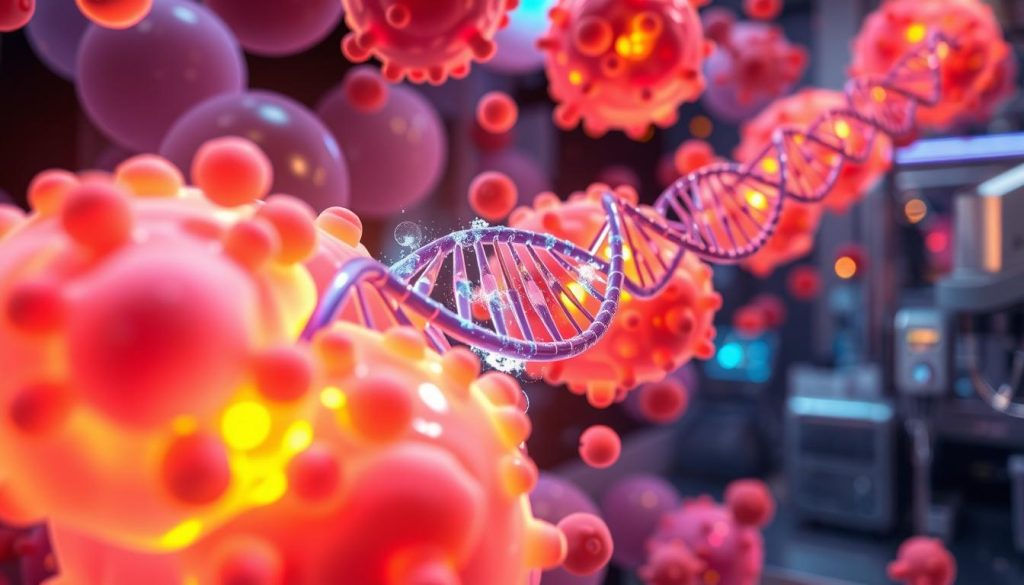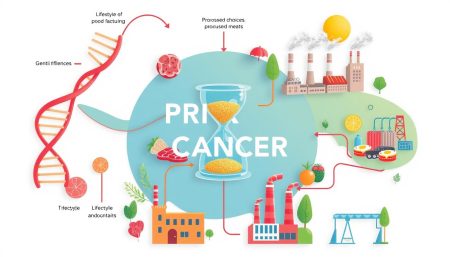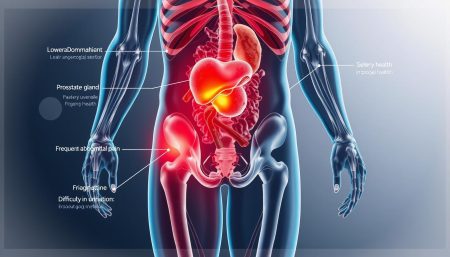CAR T cell therapy is a new way to fight cancer. It uses the body’s immune system to attack cancer cells. The process includes several steps, from the first visit to ongoing care, making sure it’s safe and works well.
In this article, we’ll look at the CAR T cell therapy process. We’ll cover T cell collection, genetic changes, growing the cells, checking their quality, and giving them back to the body.
It’s important for patients, caregivers, and doctors to understand CAR T cell therapy. We want to explain each step clearly. This way, patients can make better choices about their treatment.
Let’s explore the world of CAR T cell therapy together. See how it’s changing the fight against cancer.
Overview of CAR T Cell Therapy
CAR T cell therapy is a new way to fight cancer. It uses a patient’s own immune system to attack cancer cells. This method changes T cells to recognize and destroy cancer cells, but not healthy ones.
The first step is to collect T cells from the patient. This is done through a process called leukapheresis. Then, these T cells are sent to a lab for gene transfer. The lab adds a gene that makes the T cells target cancer cells.
After the T cells are modified, they are grown in the lab. This makes a lot of CAR T cells. These cells are then given back to the patient. They multiply and find and kill cancer cells.
This method is very effective against some blood cancers. It works well for:
- Acute Lymphoblastic Leukemia (ALL)
- Diffuse Large B-Cell Lymphoma (DLBCL)
- Multiple Myeloma
“CAR T cell therapy represents a significant advance in the field of cancer immunotherapy, giving hope to patients with previously incurable blood cancers.”
The table below shows the CAR T cell therapies approved by the FDA for blood cancers:
| CAR T Cell Therapy | Target Antigen | Approved Indications |
|---|---|---|
| Kymriah | CD19 | ALL, DLBCL |
| Yescarta | CD19 | DLBCL |
| Tecartus | CD19 | Mantle Cell Lymphoma |
| Breyanzi | CD19 | DLBCL |
| Abecma | BCMA | Multiple Myeloma |
| Carvykti | BCMA | Multiple Myeloma |
Researchers are also looking into using CAR T cell therapy for solid tumors. It has the chance to give long-term remission or even a cure for some patients. This makes CAR T cell therapy a promising area in cancer treatment.
Initial Consultation and Eligibility Assessment
Before starting CAR T cell therapy, patients go through a detailed initial consultation and eligibility check. This step is key to see if the treatment fits the patient’s health history, current health, and cancer type.
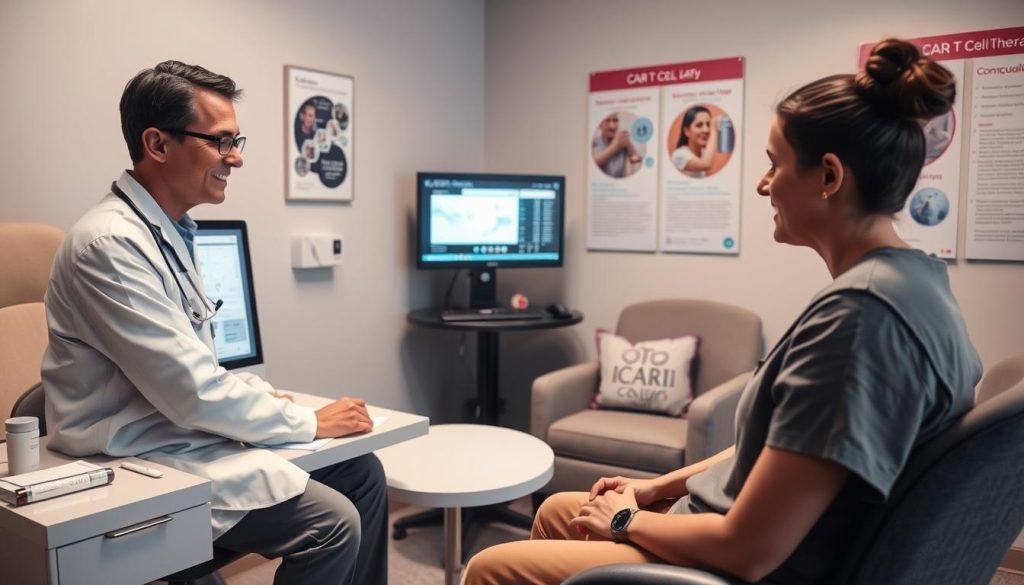
In the consultation, the medical team looks at the patient’s medical records. They check past treatments, medicines, and any health issues. This helps them understand the treatment’s risks and benefits for the patient.
Medical History Review
Reviewing the patient’s medical history is vital. The team looks at:
- Type and stage of cancer
- Previous cancer treatments and their outcomes
- Comorbidities and chronic health conditions
- Current medications and possible interactions
Physical Examination
The patient gets a detailed physical check-up. This assesses their health and readiness for treatment. The exam includes:
- Vital signs (blood pressure, heart rate, temperature)
- Evaluation of organ function (heart, lungs, liver, kidneys)
- Neurological assessment
- Assessment of performance status
Diagnostic Tests
Diagnostic tests are done to check the patient’s eligibility and gather data. These tests include:
| Test | Purpose |
|---|---|
| Blood tests | Check organ function, blood cell counts, and tumor markers |
| Imaging studies (CT, PET, MRI) | See how far the disease has spread and if it has reached other parts of the body |
| Bone marrow biopsy | Check for cancer cells in the bone marrow |
| Lumbar puncture | Look for cancer cells in the cerebrospinal fluid |
The test results help the team understand the patient’s health and cancer extent. This is important for deciding if CAR T cell therapy is right for them.
The initial consultation and eligibility assessment are key. They ensure CAR T cell therapy is the best choice for each patient. This approach aims for the best results while keeping risks low.
Leukapheresis: Collecting the Patient’s T Cells
The first step in CAR T cell therapy is leukapheresis. This process collects the patient’s T cells from their blood. These T cells will be changed to fight cancer cells.
Leukapheresis draws blood from the patient’s arm. It uses a machine to separate T cells from other blood parts. The machine returns the other blood parts to the patient. This process takes 3-6 hours and might be done more than once to get enough T cells.
Patients might feel cold or numb during the procedure. This is because of the anti-coagulant used to prevent blood clots. But these feelings usually go away soon after.
“Leukapheresis is a well-tolerated procedure, and most patients are able to resume their normal activities the same day or the following day,” explains Dr. Sarah Thompson, a hematologist at City Hospital.
After collecting T cells, they go to a lab for genetic changes. These changes make the T cells target cancer cells. This takes a few weeks, and the patient might get other treatments during this time.
Getting T cells through leukapheresis is a big step. It moves the patient closer to a treatment that could save their life.
Genetic Modification of T Cells
First, the patient’s T cells are collected through a process called leukapheresis. Then, they go through a key step called genetic modification. This makes the T cells into strong fighters against cancer, known as CAR T cells.
The genetic modification adds a special gene, called the CAR gene, to the T cells. This gene tells the T cells how to make a chimeric antigen receptor (CAR) on their surface. The CAR is made to find and stick to proteins on cancer cells, helping the T cells attack and kill them.
Introduction of CAR Gene
To add the CAR gene to the T cells, scientists use a method called viral vector transduction. This method uses modified viruses to carry genetic material into cells safely. The most used viruses in CAR T cell therapy are from retroviruses or lentiviruses.
The CAR gene is packed into the viral vector and mixed with the T cells in a lab. The virus then carries the gene into the T cells, adding it to their DNA. This makes the CAR gene a permanent part of the T cell, allowing it to produce the CAR protein.
Viral Vector Transduction
Viral vector transduction is a fast and effective way to add the CAR gene to T cells. It allows many T cells to be modified quickly. The viruses used are carefully made and tested to be safe and avoid any bad effects.
After the T cells are modified with the CAR gene, they are grown and prepared in the lab. Then, they are given back to the patient. These modified T cells, now able to find and fight cancer cells, are the core of CAR T cell therapy.
T Cell Expansion and Cultivation
After modifying T cells to express the chimeric antigen receptor (CAR), they go through a key stage in the lab. This stage is vital to get enough CAR T cells for treatment. Scientists use specific growth factors to help the cells grow and stay alive.
Stimulation with Growth Factors
To boost the cell expansion process, scientists use growth factors and cytokines. These molecules send signals to the CAR T cells, making them multiply quickly. Some common growth factors include:
- Interleukin-2 (IL-2)
- Interleukin-7 (IL-7)
- Interleukin-15 (IL-15)
- Anti-CD3/CD28 antibodies
The choice of growth factors depends on their ability to help T cells grow while keeping them functional. The right mix and amount can change based on the CAR type and the patient’s T cells.
Monitoring Cell Growth and Viability
During expansion, CAR T cells are watched closely to check their growth and health. Scientists use different methods to check the cells’ condition, like:
| Technique | Purpose |
|---|---|
| Flow cytometry | Measures CAR expression levels and T cell phenotype |
| Trypan blue exclusion | Assesses cell viability and counts live cells |
| Cytokine production assays | Evaluates the functional activity of CAR T cells |
By keeping a close eye on the CAR T cells, scientists make sure they are ready for use. The goal is to have enough CAR T cells that can find and kill cancer cells well.
“The success of CAR T cell therapy heavily relies on the quality and quantity of the expanded T cells. Careful optimization of the expansion process is critical for the best patient outcomes.”
Quality Control and Testing
After growing and preparing CAR T cells, a key step is quality control testing. This step checks if the cells are safe, pure, and strong enough before they go back into the patient.
Quality control testing checks the CAR T cells in many ways. These include:
- Sterility testing to make sure there’s no bacteria or viruses
- Viability testing to see if the cells are alive and working right
- Purity testing to make sure most cells are the right kind
- Potency testing to see if the cells can find and kill cancer cells

They also check how well the CAR T cells work. This is called transduction efficiency. A high efficiency means the therapy can target and kill cancer cells better.
Testing also looks at the CAR T cells’ phenotype and function. This uses advanced methods like flow cytometry. It helps make sure the cells are what they should be after they’ve been changed and grown.
“Quality control testing is a critical step in the CAR T cell therapy process, as it ensures that the patient receives a safe, pure, and potent cell product that has the best chance of delivering a successful treatment outcome.”
Only when all tests are passed and criteria are met can the CAR T cell product be ready for the patient. This detailed testing is vital for keeping patients safe and making sure the treatment works well.
Lymphodepleting Chemotherapy
Before giving the CAR T cells back to the patient, a key step is lymphodepleting chemotherapy. This treatment is vital for making the CAR T cells work better. It helps improve how well the treatment works for the patient.
Purpose of Lymphodepletion
The main goal of lymphodepleting chemotherapy is to help the CAR T cells grow and work well in the body. It reduces the number of immune cells that might compete with the CAR T cells. This lets the CAR T cells fight cancer more effectively.
Also, lymphodepleting chemotherapy:
- Increases cytokines that help CAR T cells grow and survive
- Lessens the chance of the body rejecting the CAR T cells
- Makes the CAR T cells last longer and work better over time
Commonly Used Chemotherapy Regimens
The type of chemotherapy used can change based on the CAR T cell product, the patient’s health, and the treatment center’s rules. Some common regimens for lymphodepletion in CAR T cell therapy include:
| Regimen | Drugs | Dosage and Schedule |
|---|---|---|
| Flu/Cy | Fludarabine and Cyclophosphamide | Fludarabine: 30 mg/m2 daily for 3 days Cyclophosphamide: 300-500 mg/m2 daily for 3 days |
| Cy | Cyclophosphamide | 900-3000 mg/m2 single dose |
| Flu | Fludarabine | 30 mg/m2 daily for 3-5 days |
“Lymphodepleting chemotherapy is a critical component of the CAR T cell therapy process, as it helps create a conducive environment for the infused CAR T cells to expand, persist, and effectively target cancer cells.”
Knowing about lymphodepleting chemotherapy helps patients and their families get ready for this important part of CAR T cell therapy.
CAR T Cell Infusion
After the lymphodepleting chemotherapy, the patient is ready for the CAR T cell infusion. This is a key step in the therapy. It involves preparing the patient, giving the infusion, and watching for any bad reactions.
Patient Preparation
Before the infusion, the patient gets checked to make sure they’re ready. This includes:
- Vital signs assessment
- Blood tests to check for infection and organ function
- Medication review and adjustment, if necessary
- Placement of a central venous catheter for the infusion
Infusion Process
The infusion happens in a special unit or intensive care setting. The steps are:
- Premedication with acetaminophen and diphenhydramine to minimize infusion reactions
- Thawing the cryopreserved CAR T cells to room temperature
- Infusing the CAR T cells through the central venous catheter over 30-60 minutes
- Flushing the catheter with saline to ensure complete delivery of the cells
Monitoring for Adverse Reactions
During and after the infusion, the patient is watched closely for bad reactions. Common side effects include:
| Adverse Reaction | Symptoms | Management |
|---|---|---|
| Cytokine Release Syndrome (CRS) | Fever, hypotension, hypoxia, organ dysfunction | Supportive care, tocilizumab, corticosteroids |
| Neurotoxicity | Confusion, aphasia, seizures, cerebral edema | Supportive care, corticosteroids |
| Tumor Lysis Syndrome | Electrolyte abnormalities, renal dysfunction | Hydration, allopurinol, rasburicase |
The CAR T cell infusion is a landmark moment in the patient’s journey, representing the culmination of weeks of preparation and the beginning of their path to possible remission.
The healthcare team closely watches and manages any bad reactions. This ensures the patient’s safety and well-being as they start this new cancer treatment.
Post-Infusion Monitoring and Care
After CAR T cells are infused, patients start a critical phase of monitoring. Healthcare providers watch for side effects or complications closely. They aim to quickly spot and handle any issues to ensure the best results.
Patients usually stay in the hospital for days to weeks after infusion. This depends on how they react and if they have side effects. They get regular checks, including:
- Vital sign monitoring (temperature, blood pressure, heart rate, and respiratory rate)
- Blood tests to check organ function and watch for cytokine release syndrome (CRS)
- Neurological assessments to look for signs of neurotoxicity
- Imaging studies, like CT scans or PET scans, to see how the treatment is working and if the disease is getting worse
A team of doctors, nurses, and specialists work together to care for patients during this time. They might give medicines to handle side effects, like tocilizumab for CRS or corticosteroids for neurotoxicity.
Patients and their caregivers learn to spot and report any worrying symptoms. These include fever, chills, confusion, or trouble breathing. Quick action is key to managing any problems.
| Monitoring Parameter | Frequency | Purpose |
|---|---|---|
| Vital Signs | Every 4-6 hours | Detect early signs of CRS or infection |
| Blood Tests | Daily or as needed | Monitor organ function and cytokine levels |
| Neurological Assessment | Daily or as needed | Identify signs of neurotoxicity |
| Imaging Studies | As clinically indicated | Assess treatment response and disease status |
When patients are stable and don’t need close monitoring anymore, they might go home. But they keep seeing their healthcare team for check-ups. This is to watch for any late side effects or signs of the disease coming back.
Potential Side Effects and Their Management
CAR T cell therapy has been a game-changer for some cancers. But, it can cause side effects that need careful watching. The main issues are cytokine release syndrome (CRS), neurotoxicity, and B cell aplasia.
Cytokine Release Syndrome (CRS)
CRS happens when the immune system goes into overdrive. This can cause a big release of cytokines in the blood. Symptoms range from mild fever to serious problems like low blood pressure and organ failure.
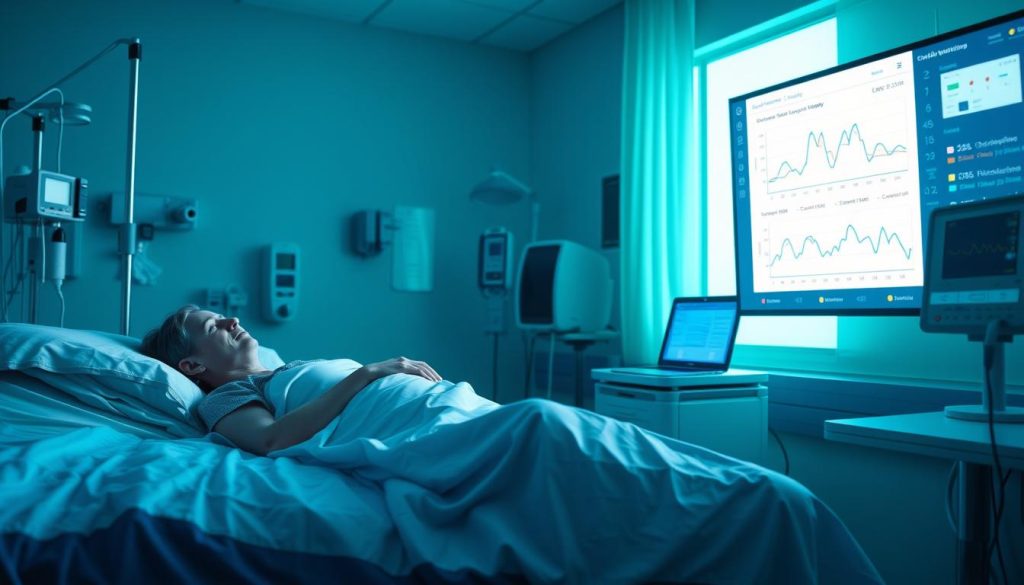
Handling CRS depends on how bad the symptoms are. Treatment might include:
- Fluids and oxygen to support the body
- Medicines to lower inflammation, like corticosteroids
- Tocilizumab, a drug that blocks IL-6, a cytokine involved in CRS
Neurotoxicity
Neurotoxicity, or ICANS, is when the immune system attacks the brain. Symptoms can be confusion, tremors, seizures, and changes in mental state.
For neurotoxicity, treatment often includes:
- Corticosteroids to calm brain inflammation
- Anti-seizure drugs to control tremors and seizures
- Supportive care, like breathing help if needed
B Cell Aplasia
B cell aplasia happens when CAR T cells target and destroy B cells. B cells are key for making antibodies. This makes it harder for the body to fight off infections.
Managing B cell aplasia involves:
- IVIG therapy to give the body antibodies
- Antibiotics to prevent infections
- Watching for signs of infection and treating them quickly
The table below shows the side effects and how to manage them:
| Side Effect | Management Strategies |
|---|---|
| Cytokine Release Syndrome (CRS) | Supportive care, corticosteroids, tocilizumab |
| Neurotoxicity (ICANS) | Corticosteroids, anti-epileptic medications, supportive care |
| B Cell Aplasia | IVIG therapy, prophylactic antibiotics, monitoring for infections |
Long-Term Follow-Up and Outcomes
After CAR T cell therapy, patients start a critical follow-up phase. This phase is key for watching their health and seeing how well the treatment worked. It also helps catch any signs of cancer coming back. Regular check-ups and tests are done to help patients get the best results.
- Physical exams
- Blood tests
- Imaging scans (e.g., CT, PET, or MRI)
- Bone marrow biopsies
These tests help doctors keep a close eye on the patient’s health. They look for any changes that might mean the cancer is coming back or if more treatment is needed.
Monitoring for Relapse
One main goal of follow-up is to watch for cancer coming back. CAR T cell therapy works well to get rid of cancer, but sometimes it can come back. Regular checks help find this early and act fast if it does.
Assessing Treatment Response
Follow-up also helps doctors see how well the treatment is working. They check if the cancer is staying away and if the CAR T cells are working right. The response is usually classified as:
| Response Category | Description |
|---|---|
| Complete Response (CR) | No detectable evidence of cancer |
| Partial Response (PR) | Significant reduction in tumor burden, but some cancer cells remain |
| Stable Disease (SD) | Cancer neither decreases nor increases significantly |
| Progressive Disease (PD) | Cancer continues to grow or spread |
Patients who get a complete or partial response might stay in remission for a long time. This means they can live better and longer. Dr. Sarah Johnson, a top oncologist, says:
The chance for long-lasting remissions with CAR T cell therapy is amazing. For many, this treatment gives hope for a cancer-free future.
By keeping a close eye on patients and checking how well the treatment is working, doctors can make care plans better. This helps patients on their path to long-term health and happiness.
CAR T Cell Therapy Process: Step-by-Step Guide
The CAR T cell therapy process is complex and involves many steps. It requires teamwork between the patient and their medical team. Here’s a guide to help you understand the main stages of this innovative cancer treatment:
- Initial consultation and eligibility assessment: Your medical team will review your medical history and perform a physical examination. They will also conduct diagnostic tests to see if CAR T cell therapy is right for you.
- Leukapheresis: If you’re eligible, your T cells will be collected through leukapheresis. This process separates white blood cells from your blood.
- Genetic modification of T cells: Your collected T cells will be sent to a laboratory. There, they will be genetically modified to target specific cancer cells.
- T cell expansion and cultivation: The genetically modified T cells will be stimulated with growth factors. They will be monitored to ensure they grow well and are viable.
- Quality control and testing: Before the CAR T cells are infused, they will undergo quality control and testing. This ensures their safety and effectiveness.
Once the CAR T cells are ready, the patient will go through the following steps:
- Lymphodepleting chemotherapy: You’ll receive a short course of chemotherapy to prepare your body for the CAR T cell infusion. This helps create space for the CAR T cells.
- CAR T cell infusion: The genetically modified CAR T cells will be infused back into your body. They will seek out and destroy cancer cells expressing the targeted antigen.
- Post-infusion monitoring and care: After the infusion, you’ll be closely monitored for any side effects. You will receive supportive care as needed.
- Long-term follow-up and outcomes: Your medical team will continue to monitor you for signs of relapse. They will assess your treatment response over time.
The duration of the CAR T cell therapy process varies. It depends on factors like the patient’s health status, the type of cancer, and the manufacturing time for the CAR T cells. Here’s a general timeline:
| Stage | Duration |
|---|---|
| Initial consultation and eligibility assessment | 1-2 weeks |
| Leukapheresis | 1 day |
| Genetic modification and expansion of T cells | 2-4 weeks |
| Lymphodepleting chemotherapy | 3-7 days |
| CAR T cell infusion | 1 day |
| Post-infusion monitoring and care | 2-4 weeks |
| Long-term follow-up | Ongoing |
CAR T cell therapy has revolutionized the treatment of certain blood cancers. It offers hope to patients who have exhausted other treatment options.
As research advances, the CAR T cell therapy process may become more streamlined. It may also become more accessible to patients with various types of cancer.
Advances and Future Directions in CAR T Cell Therapy
Researchers are making great strides in CAR T cell therapy. It’s now showing great success in treating some blood cancers. They’re working hard to use it for other cancers too, like breast, lung, and brain tumors.
They’re also trying to make it safer and more effective. Scientists are creating new CAR T cells that are more precise and less toxic. These new cells might fight cancer better and with fewer side effects.
Another big area of research is making CAR T cells that can be used by anyone. Right now, each patient’s T cells are used, which can be slow and expensive. Universal CAR T cells could make treatment faster and more accessible to everyone.
The future of CAR T cell therapy looks very promising. With ongoing research, it could change how we treat cancer. Scientists, doctors, and patients are all working together to make this happen. Their efforts could lead to a future where personalized treatments are common in cancer care.
FAQ
Q: What is CAR T cell therapy, and how does it work?
A: CAR T cell therapy is a new way to fight cancer. It changes a patient’s T cells to attack cancer. First, T cells are taken from the patient. Then, they are changed to find and kill cancer cells. After that, they are given back to the patient to fight the cancer.
Q: Who is eligible for CAR T cell therapy?
A: Who can get CAR T cell therapy depends on their cancer type and health. Doctors check the patient’s history and health to see if it’s right for them.
Q: What is the process of collecting a patient’s T cells for CAR T cell therapy?
A: Collecting T cells is called leukapheresis. Blood is taken from the patient, and T cells are separated. Then, the blood is returned to the patient. This process takes a few hours and is done outside the hospital.
Q: How are the collected T cells genetically modified to target cancer cells?
A: T cells are changed in the lab to find and attack cancer. A harmless virus is used to add a special gene to the T cells. This gene helps them find cancer cells.
Q: What happens after the T cells are genetically modified?
A: After being changed, the T cells are grown in the lab. They are given food to grow and are checked to make sure they are healthy. Once there are enough, they are tested and then given to the patient.
Q: What is the purpose of lymphodepleting chemotherapy in CAR T cell therapy?
A: Chemotherapy is given before the T cells to help them work better. It gets rid of other immune cells. This lets the T cells grow and fight cancer more effectively.
Q: What can patients expect during the CAR T cell infusion process?
A: Patients are watched closely during the infusion. It’s like getting a blood transfusion and takes less than an hour. Some may feel sick or have a fever, but these can be treated.
Q: What are the possible side effects of CAR T cell therapy, and how are they managed?
A: Side effects include fever, low blood pressure, and brain problems. These are watched and treated with medicine. Some patients may need extra help to replace missing immune cells.
Q: How long does the CAR T cell therapy process typically take from start to finish?
A: The whole process takes weeks to months. It depends on the patient’s health and how fast the T cells can be made and tested.
Q: What kind of follow-up care is required after CAR T cell therapy?
A: After treatment, patients need regular check-ups. These help make sure the cancer is gone and watch for any new problems. Blood tests and scans are part of this care.












